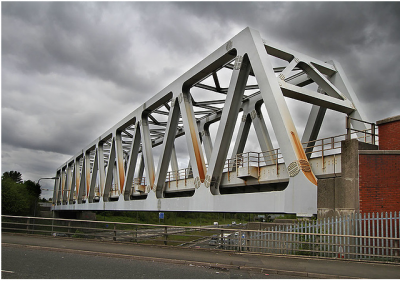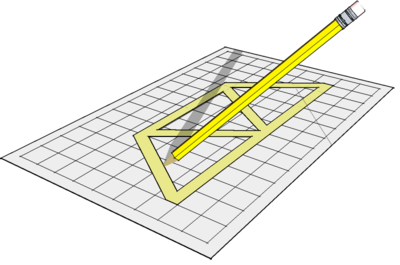- View source
- View history

Design, Make and Test a Warren Girder
From dt online, what to make:.
Design Make and Test a Warren Girder truss frame 450mm wide to span a 400mm wide gap and support a centrally applied load of 1kg

- 1 What to Make:
- 2 What to Use:
- 3 Things to find out and think about:
- 4 Some ideas:
- 5 Ways of Making:
- 7 Further Work:
- 8 DT Online Buyers' Guide
What to Use:
- Material available is restricted to 3mm thick medium density Balsa Wood .
- Use any suitable adhesive to make connections but adhesive tape is not allowed.
Things to find out and think about:
- Draw full-size a Warren Girder exactly 450mm wide
- Analyse the forces acting within a Warren Girder and determine which Members will be Struts and which will be Ties .
- Apply Bow's Notation and use Force Diagrams to determine the Forces in the Frame when the 1kg load is applied.
- Determine the Tensile Strength of medium density Balsa Wood either by testing or looking up in tables and from this establish how wide to cut Ties from 3mm thick sheet Balsa (e.g. U.T.S. should be around 15Nmm 2 - use this figure if in doubt or to check magnitude of test results) .
- Apply Euler's Buckling Equation to inform an estimate of how wide to cut the Struts from 3mm thick sheet Balsa (e.g. assume a figure for Young's Modulus (E) of 4000Nmm 2 or determine by experiment by measuring the Deflection of a balsa sample beam for example) .
Some ideas:


Ways of Making:
- Conduct some tests to establish which is the most effective adhesive and consider how each joint can be provided with an adequate gluing surface area.
- Take care when shaping and finishing the Structural Members to avoid any nicks or sharp indentations which might cause a Stress Concentration .
- Use the full-size drawing to position the Structural Members accurately and glue them in place.
Note: Cover the drawing with tracing paper to enable the truss frame to release after gluing.

- Carefully weigh the completed truss frame (ideally to 1/10 th of a gram) .
- Mount the completed truss frame in the testing rig as shown
- Suspend a mass set hanger from the centre as shown
- Add masses carefully to avoid generating a Dynamic Load until the specified load of 1kg is reached.
- Divide 1kg by the truss frame self-weight to gain a measure of the frame's efficiency (i.e. high numbers win!)
Further Work:
- Continue to load the frame until it fails and record the maximum load before failure.
- Divide the maximum load before failure by self-weight to gain a revised measure of the frame's efficiency.
- Observe how the frame failed : which Member failed first? Was it a Strut or a Tie ? Did just one Member fail or several all at once - and what would this indicate?
DT Online Buyers' Guide
- Structures and Frames can also be modelled using the Construction Kits listed in the Truss Bridges and Looking at Bridges articles.
Safety Point! Take great care with hot glue guns and all hot-melt glues. The melted glue can stick to the skin and cause severe burns.
- Choose metal cutting hacksaw blades - the teeth are small which suits this scale of work and they are safer for young children
- School PVA glue is best for young children because it is non-toxic and washes off : PVA Wood Glue is strongest but must be used with care.
- Try to get natural Flower Sticks or wear gloves because the green stain comes off on hands!
- Topics, Projects and Tasks
- Structures Projects
Academia.edu no longer supports Internet Explorer.
To browse Academia.edu and the wider internet faster and more securely, please take a few seconds to upgrade your browser .
Enter the email address you signed up with and we'll email you a reset link.
- We're Hiring!
- Help Center

Download Free PDF
Internal Forces in a Structure

AI-generated Abstract
This research focuses on the internal forces within structural frameworks, specifically trusses. It discusses the principles of rigidity and stability in truss construction, introduces methods for calculating forces using the method of joints, and presents an experimental procedure to validate theoretical outcomes through practical measurements. The findings reveal discrepancies between theoretical and experimental values, emphasizing the importance of considering various load cases and structural responses, including the role of zero-force members in maintaining balance.

IMAGES
COMMENTS
We are using a Warren Girder structure controlled by an electronic load cell used to apply forces in the members of the structure,and the sensors, called strain gauges, will determine the load applied and the results are shown on the digital force apparatus used during the experiment.
The document describes a lab experiment investigating the forces in members of a Warren girder structure under increasing loads. Strain gauges and sensors measured the strain and deflection of each member as loads from 0-500N were applied. The experimental results showed differences from theoretical calculations, which may be due to non-uniform member diameters, varied elastic modulus of the ...
Draw full-size a Warren Girder exactly 450mm wide; Analyse the forces acting within a Warren Girder and determine which Members will be Struts and which will be Ties. Apply Bow's Notation and use Force Diagrams to determine the Forces in the Frame when the 1kg load is applied.
1. The experiment examines how the forces in each member of a statically determinate Warren girder structure vary with a central variable load. Strain gauges are used to measure the forces in each member as the load is increased incrementally. 2. Experimental data on member strains and joint deflection are recorded in Table 1.0 for various load levels. True member strains must be calculated ...
May 2, 2019 · Below is a structural model of a girder relevant for this experiment: Figure 1: A Diagram Showing a Warren Girder with a Central Load This experiment is aimed at examining and determining the forces in each member of a statically determinate warren girder, an example is above.
Dec 24, 2021 · LAB 06 Warren Girder Apparatus Experiment 06 Objective: To determine forces in the members of a loaded Warren Girder and then compare them with theoretically calculated values. Apparatus: 1. Warren Girder 2. Hangers 3. Weights 4. Measuring tape 5. Vernier calliper etc. Diagram: Figure 1: Warren Girder Apparatus Engineering Mechanics Lab Manual1 ...
The figure 2 below shows a warren girder consisting of eleven members and freely supported at its end points. The girder is loaded at points C, E, G, D and F. Using the method of section, Determine the forces in members AD, CD, CE, DE, DF, EF, EG and FE, indicating whether the forces are Tension or compression. (20 Marks) Question THREE (a).
The purpose of this lab is to examine and analyze forces taken in an experiment using a warren girder and comparing them with the theoretical forces calculated with mathematical methods of joints and the method of sections.
The figure below shows a warren girder consisting of seven members each 3m length, freely supported at its end points. The girder is loaded at B and C as shown. Using the graphical method find forces in all the members, indicating whether the force is compressive or tensile. (20 Marks) C E A D B 3m 60q 60q 2KN 4KN 3m Question FOUR (a).
The document describes procedures for analyzing the loading pattern on a Warren Girder structure using a laboratory apparatus. The experiment involves measuring deflections of spring balances under different load configurations to determine forces in each frame member. Students are instructed to record measurements in a table and calculate member forces based on spring deflection and ...